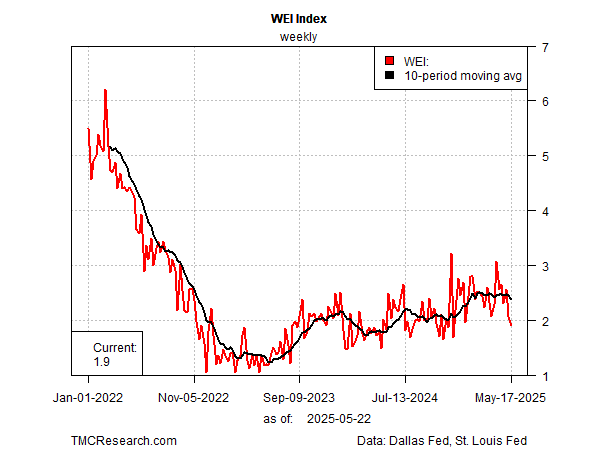Headwinds For US Economy May Be Lurking, But Recession Risk Remains Low For Now
By James Picerno | The Milwaukee Company
US economic growth remains likely for the near term, despite concerns about tariffs and the budget deficit.
Nowcasts for GDP in Q1 are signaling a rebound after the contraction in Q1.
A complicating factor is bond market turbulence, driven by rising yields amid concerns about government debt and Moody’s US credit rating downgrade.
Although concerns persist regarding tariffs and the US budget deficit – risks that could inhibit economic activity -- several key high-frequency indicators still indicate that economic growth remains probable for the near term.
In a sign of increasing challenges ahead, however, the bond market is demanding higher yields. Fueling the change in risk appetite is the perception of higher macro risk linked to tariffs and the recent downgrade in the US credit rating by Moody’s. Another concern: the government’s already hefty deficit will deepen in the years ahead under the bill that passed the House of Representatives and is now in the Senate.
The good news is that the economy still has a tailwind, despite the slight contraction in GDP in the first quarter, which was largely an accounting issue triggered by a surge in imports driven by companies stockpiling goods ahead of tariffs. The second quarter looks set to repair the setback and post a solid rebound.
The Atlanta Fed’s GDPNow model is currently nowcasting a 2.4% rise in output in Q2 after the 0.3% decline in Q1. The New York Fed’s nowcasting model is also estimating a 2%-plus rise for GDP in the current quarter.
The Dallas Fed’s Weekly Economic Index (WEI) offers another sign that growth remains intact, although hints of slowing have been emerging. WEI, which tracks 10 indicators that cover the consumer sector, the labor market and production activity, has been downshifting lately; the current reading estimates the year-over-year economic change at 1.9% (based on data through May 19), or moderately below the 2.1% four-quarter growth for US GDP reported through Q1.
Business-cycle risk for the near term also remains low, according to the Philadelphia Fed’s ADS Index, another multi-factor real-time indicator of economic activity. But here, too, there a signs of weakening. ADS has been printing at a below-average reading lately, but the current level (-0.11 as of May 17) is middling vs. recent history and is still far above -0.80, which equates with recession trigger level (red line in chart below).
The weeks and months ahead, however, could bring new challenges for the economy on two fronts. First, the ramifications of tariffs have yet to be fully reflected in economic data and so it remains to be seen how incoming data changes the analysis. As the numbers for May, and subsequent months, are published, a clearer profile will emerge for assessing the effects of raising import levies.
Investors will also be closely monitoring how the bond market reacts to expectations that the federal government’s debt burden will grow in the years ahead if the House domestic tax-and-spending bill becomes law.
The 30-year Treasury yield, which is especially sensitive to inflation expectations, topped 5% this week for the first time since late-2023. Official inflation data, however, is still modest, leaving room for debate about how pricing pressure will evolve this year.
The Consumer Price Index’s 1-year change dipped to 2.3% in April, the lowest since February 2021, according to the Bureau of Labor Statistics. Inflation hawks worry that the disinflation trend will fade and possibly reverse as tariff effects and worries about the budget deficit reverberate and send Treasury yields higher as investors demand a higher risk premium. In turn, higher rates could slow economic activity as borrowing costs increase.
For now, however, the economy appears to be growing moderately. Despite recent fears that the US economy was slipping into recession, the numbers published to date continue to indicate otherwise. The trend for Treasury yields going forward will be a critical factor for monitoring how the macro risk outlook evolves.




